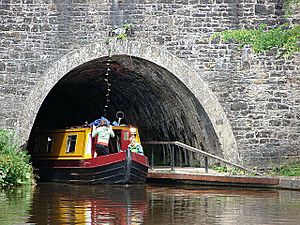Chirk Tunnel facts for kids
 |
|
| Chirk tunnel viewed from Chirk aqueduct. | |
| Overview | |
|---|---|
| Coordinates | 52°55′53.13″N 3°3′53.9″W / 52.9314250°N 3.064972°W |
| OS grid reference | SJ284376 |
| Status | Open |
| Waterway | Llangollen Canal |
| Start | 52°55′46.93″N 3°3′46.73″W / 52.9297028°N 3.0629806°W |
| End | 52°55′57.5″N 3°4′0.33″W / 52.932639°N 3.0667583°W |
| Operation | |
| Owner | Canal & River Trust |
| Technical | |
| Design engineer | William Jessop Thomas Telford |
| Construction | 1794–1802 |
| Length | 421 m (1,381 ft) |
| Towpath | Yes |
| Boat-passable | No |
The Chirk Tunnel is a canal tunnel located near Chirk, Wales. It's an important part of the Llangollen Canal, found just north of the famous Chirk Aqueduct.
This tunnel is 421 metres (460 yd) long. It's special because it has a complete path inside, called a towpath. This path allows people to walk through the tunnel. The tunnel is only wide enough for one narrowboat at a time, so boats cannot pass each other inside.
Because the tunnel is quite straight, you can usually see if another boat is already inside. Boats are required to use a light when going through. If a boat is heading north, it needs to keep its engine strong. This is because the water inside the tunnel is shallow and narrow. Also, there's a gentle current of about 2 miles per hour (3.2 km/h) flowing south. The tunnel, its entrances, and the canal basin are all considered important historical structures.
History of Chirk Tunnel
In 1791, people started planning a large network of canals called the Ellesmere Canal. The goal was to connect the Chester Canal to Shrewsbury. They also wanted branches to places like Ruabon and Llangollen.
The planners asked a famous engineer named William Jessop to look at their ideas. He suggested a slightly different route. This new route would include three tunnels. One long tunnel was planned for Ruabon, another for Weston, and a third, shorter tunnel at Chirk. This Chirk tunnel would go under the Froncysyllte limeworks.
In February 1793, different groups who supported various routes decided to work together. On April 30, 1793, an Act of Parliament officially approved the canal project. Many changes were made to the plans during this time. The canal at Chirk was moved to cross the River Ceiriog at a new spot. This change made the Chirk tunnel much shorter than first planned.
The contract to build the nearby aqueduct was signed in January 1796. The aqueduct was finished in 1801. An 8 miles (13 km) section of the canal, going east to Frankton, opened right away. This was important for transporting valuable limestone from the Fron Quarries. The section of the canal that included the Chirk Tunnel opened in June 1802. This part also went through another tunnel called Whitehurst Tunnel.
Walking Through the Tunnel
The Chirk Tunnel is believed to be one of the first tunnels in Britain to have a towpath running all the way through it. Its shorter neighbor, Whitehurst Tunnel, also had a towpath. However, the Berwick Tunnel on the Shrewsbury Canal was open by 1797 and also had a towpath along its 970-yard (890 m) length.
Since the Chirk Tunnel has no lights inside, it gets completely dark in the middle. It's a good idea to use a torch/flashlight if you walk through it. For safety, there is a wooden handrail along the entire length of the tunnel. This handrail helps prevent walkers from accidentally falling into the canal.


